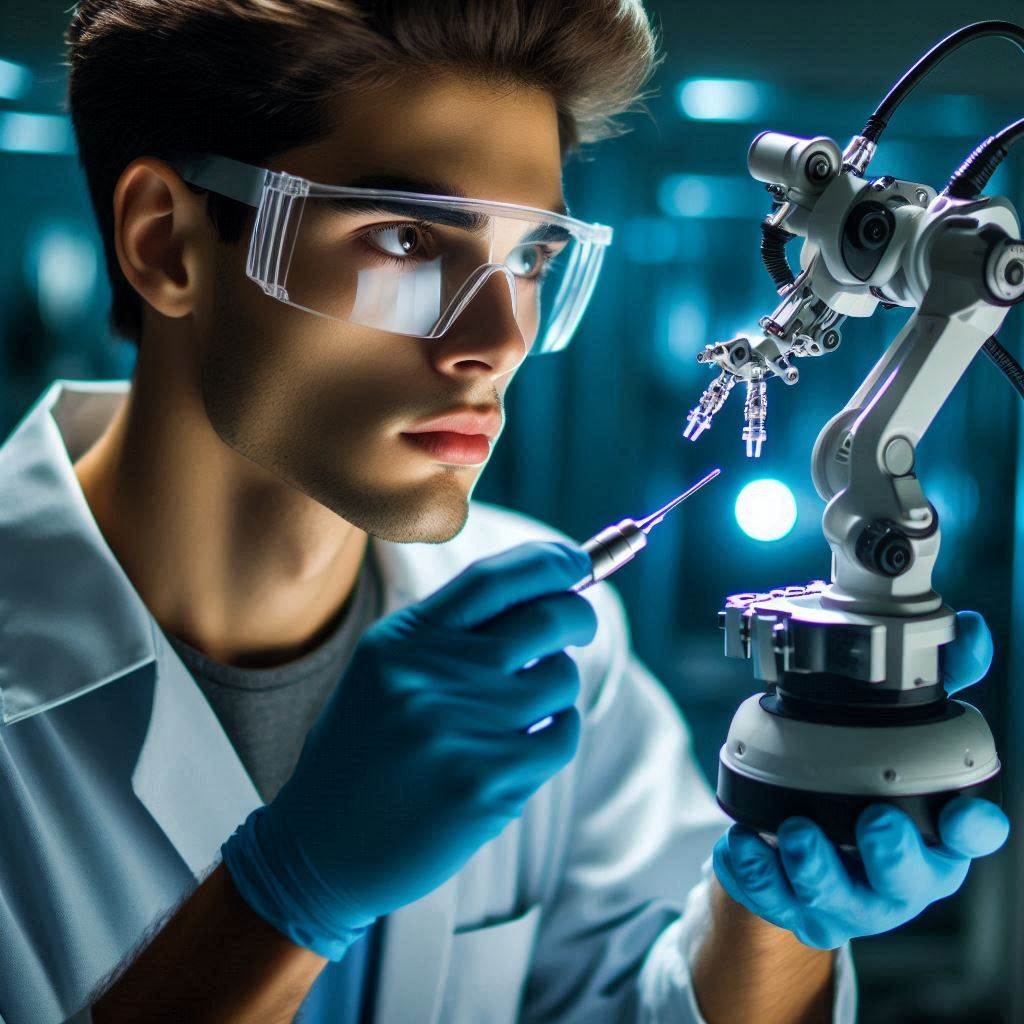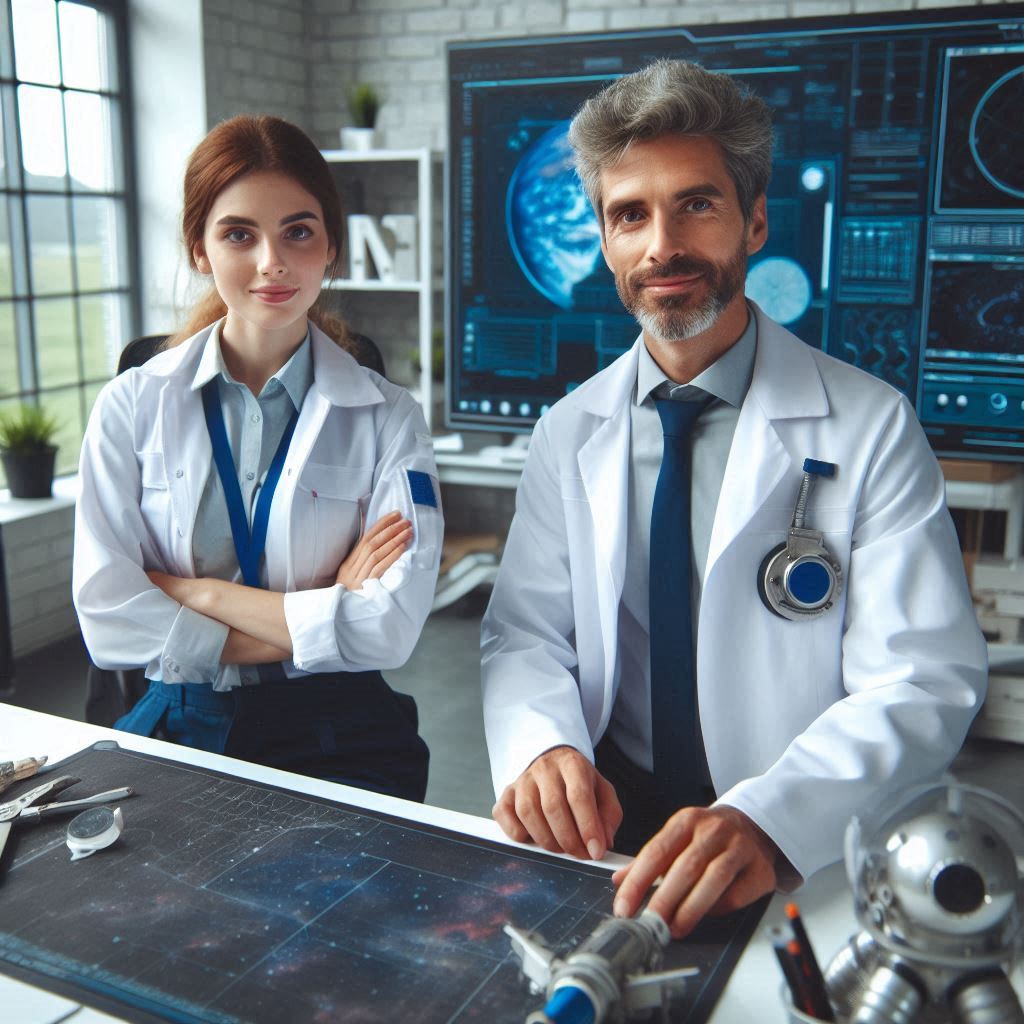Introduction
Biomedical engineering combines technology and medicine to innovate healthcare solutions.
Robotics plays a pivotal role, revolutionizing various aspects of medical procedures.
The integration of robotics enhances precision, efficiency, and overall patient outcomes.
Robotic systems are transforming the medical field in several ways.
Surgeons now use robotic-assisted tools to perform complex operations with unprecedented accuracy.
This technology minimizes invasiveness, which leads to shorter recovery times and reduced patient discomfort.
Additionally, robotics contribute to advanced imaging techniques, enabling more accurate diagnostics and treatments.
Rehabilitation also benefits from robotics, with devices aiding in physical therapy and motor recovery.
By providing targeted support and feedback, these robots help patients regain functionality more effectively.
This blog will delve into the benefits and advancements brought by robotics in biomedical engineering.
We will explore how robotic innovations are shaping modern medical practices and enhancing patient care.
Robotics in medicine represents a significant advancement, promising continued improvements in healthcare technology.
History of robotics in medicine
Robotics in medicine has a long and fascinating history that dates back several decades.
The field has seen significant advancements and milestones that have revolutionized the way medical procedures are performed.
Key Milestones and Advancements in the Field
Robotics in medicine has advanced significantly over the past few decades.
Key milestones include the development of early assistive devices and the evolution into sophisticated surgical robots.
These advancements have transformed the field of healthcare, offering new solutions for patient care.
One major milestone was the introduction of robotic-assisted surgeries in the late 1990s.
These early systems provided surgeons with enhanced precision and control during procedures.
As technology improved, robotic systems became more advanced, offering greater flexibility and capabilities.
Another significant advancement was the integration of robotic systems with imaging technologies.
This development allowed for real-time guidance and improved accuracy in complex procedures.
The use of robotics in minimally invasive surgeries has also become a major milestone, reducing recovery times and improving patient outcomes.
The Evolution of Robotics from Assistive Devices to Surgical Robots
Robotics in medicine began with assistive devices designed to aid individuals with mobility impairments.
Early examples include robotic exoskeletons and assistive robots that helped with daily activities.
These devices provided valuable support and enhanced the quality of life for many patients.
The field then evolved to include surgical robots.
The da Vinci Surgical System, introduced in 2000, marked a significant shift.
This system allowed for precise, minimally invasive surgeries using robotic arms controlled by a surgeon at a console.
It represented a major advancement from traditional surgical methods.
Today, surgical robots continue to evolve, incorporating advanced features such as artificial intelligence and machine learning.
These technologies enable robots to assist with more complex procedures and provide real-time feedback to surgeons.
The ongoing development of robotics in medicine highlights the field‘s dynamic nature and its potential for further innovation.
Impact of Robotics on Medical Procedures and Patient Outcomes
Robotics has had a profound impact on medical procedures and patient outcomes.
The precision of robotic systems allows for more accurate surgeries with fewer complications.
Surgeons can perform complex tasks with greater control, leading to improved results.
Minimally invasive procedures facilitated by robotics offer several benefits.
Patients experience smaller incisions, reduced pain, and shorter recovery times.
This approach also lowers the risk of infection and promotes faster healing, enhancing overall patient satisfaction.
Robotics also improves surgical outcomes by providing enhanced visualization and dexterity.
Surgeons can view detailed images and manipulate instruments with greater precision.
This capability is particularly valuable in delicate procedures, such as those involving the brain or spine.
Additionally, robotics contributes to advancements in rehabilitation and prosthetics.
Robotic exoskeletons help individuals regain mobility and strength, while advanced prosthetics offer improved functionality and adaptability.
These innovations support better patient outcomes and enhance the quality of life for many individuals.
Robotics in medicine has evolved from early assistive devices to advanced surgical robots, marking significant milestones in the field.
The impact of robotics on medical procedures is profound, offering enhanced precision, improved patient outcomes, and faster recovery times.
As technology continues to advance, robotics will play an increasingly important role in transforming healthcare and improving the lives of patients worldwide.
Applications of robotics in medicine
There are various applications of robotics in the field of medicine that are revolutionizing healthcare. These applications include:
Surgical robots for minimally invasive procedures
Surgical robots have significantly transformed the way surgeries are performed.
They allow surgeons to operate with more precision, flexibility, and control.
These robots are equipped with high-definition cameras and specialized tools that enable them to perform complex procedures with minimal invasiveness.
This results in faster recovery times, reduced pain, and lower risk of complications for patients.
Examples of surgical robots include the da Vinci Surgical System, which is used for procedures such as prostatectomies and hysterectomies.
Rehabilitation robots for physical therapy and assistance
Rehabilitation robots are designed to assist patients with mobility impairments in their recovery process.
These robots can help patients regain strength, improve coordination, and enhance their overall physical function.
They are equipped with sensors and intelligent algorithms that tailor the therapy to each individual’s needs.
Rehabilitation robots can be used in various settings, such as hospitals, rehabilitation centers, and even in patients’ homes.
Examples of rehabilitation robots include exoskeletons and robotic therapy devices.
Robotic prosthetics for amputees
Robotic prosthetics are advanced artificial limbs that use robotic technology to restore limb function for amputees.
These prosthetics are designed to mimic the movements of a natural limb and provide wearers with greater control and dexterity.
Robotic prosthetics can significantly improve the quality of life for amputees by enabling them to perform everyday tasks more independently.
These devices are customizable and can be tailored to suit the specific needs of each individual.
Medical imaging and diagnostics with robotic technology
Robotic technology has also revolutionized medical imaging and diagnostics.
Robots are being used to assist in procedures such as MRI-guided biopsies, where they can precisely target and extract tissue samples for analysis.
Robotic systems can also enhance imaging techniques by providing more accurate and detailed images of the body.
Additionally, robots are being developed to automate diagnostic tests and procedures, improving efficiency and accuracy in healthcare settings.
This technology has the potential to revolutionize the way diseases are detected and diagnosed.
Most Importantly, robotics is playing an increasingly important role in the field of medicine, offering innovative solutions to improve patient care and outcomes.
The applications of robotics in medicine continue to expand, opening up new possibilities for the future of healthcare.
With ongoing advancements in technology, we can expect to see even more groundbreaking developments in this field in the years to come.
Read: Decoding the Ethics & Responsibilities of US Civil Engineers
Benefits of using robotics in medicine
Improved Precision and Accuracy in Surgeries
Robotic systems significantly enhance precision and accuracy in surgeries.
These advanced robots provide surgeons with superior control over surgical instruments.
The precise movements of robotic arms allow for intricate procedures through small incisions, improving overall surgical outcomes.
Robotic technology offers a magnified, high-definition view of the surgical area.
This enhanced visualization enables surgeons to perform delicate tasks with greater detail.
Improved precision reduces the risk of errors and ensures that surgeries are conducted with high accuracy.
By refining surgical techniques, robotic systems contribute to better alignment and placement of implants or devices.
This increased accuracy results in more effective treatments and fewer complications, leading to overall improved patient care.
Reduced Risk of Human Error
Robotic assistance in surgeries helps reduce the risk of human error.
Robots provide consistent and stable movements, minimizing the impact of surgeon fatigue or hand tremors.
This stability ensures that surgical procedures are executed with high precision.
Robotic systems are programmed with safety protocols and error-checking mechanisms.
These features help prevent mistakes and ensure that each step of the procedure is performed correctly.
By minimizing human error, robotic technology enhances the reliability of surgical outcomes.
Additionally, robots can automate repetitive tasks, reducing the chances of oversight.
This automation supports surgeons in maintaining focus and consistency throughout complex procedures.
The overall reduction in human error contributes to safer and more successful surgeries.
Faster Recovery Times for Patients
Robotic-assisted surgeries often lead to faster recovery times for patients.
The minimally invasive nature of robotic procedures results in smaller incisions and less tissue damage.
As a result, patients experience reduced pain and quicker healing.
The precision of robotic systems also contributes to faster recovery.
Accurate procedures minimize complications and postoperative issues, allowing patients to resume normal activities sooner.
The reduced need for extended hospital stays further accelerates the recovery process.
Patients who undergo robotic-assisted surgeries typically report improved overall satisfaction.
The combination of less pain, quicker recovery, and fewer complications enhances the patient experience and contributes to better health outcomes.
Enhanced Patient Care and Outcomes
Robotic technology enhances patient care by improving the effectiveness of surgical treatments.
The precision and reduced risk of error translate into more successful surgeries and better health outcomes.
Enhanced surgical techniques lead to fewer complications and a higher quality of care.
Patients benefit from robotic surgeries through faster recovery times and reduced discomfort.
The minimally invasive approach allows for quicker return to daily activities and a more comfortable postoperative experience.
Overall, robotic systems contribute to improved patient satisfaction and well-being.
Robotic technology also supports personalized treatment plans.
Surgeons can tailor procedures to the individual needs of each patient, optimizing outcomes and minimizing risks.
This personalized approach further enhances patient care and ensures that treatments are aligned with specific health requirements.
Robotics in medicine has revolutionized surgical precision, reduced human error, and accelerated patient recovery.
Enhanced accuracy and stability improve surgical outcomes, while faster recovery times contribute to better patient experiences.
Overall, robotic technology plays a critical role in advancing patient care and achieving optimal health outcomes.
As robotic systems continue to evolve, their impact on medical treatments and patient care will grow, driving further innovations and improvements in healthcare.
Read: Top Cities for Electrical Engineering Jobs in America
Challenges and limitations of robotics in medicine
Biomedical engineering is revolutionizing the field of medicine with the integration of robotics.
However, there are challenges and limitations that need to be addressed for widespread adoption.
High Initial Costs and Maintenance Expenses
Robotic systems in medicine come with high initial costs.
These advanced systems often require significant investment for purchase and installation.
The expense includes the robotic equipment itself, as well as the necessary infrastructure upgrades.
Hospitals and clinics must also account for ongoing maintenance costs.
Maintenance expenses can be substantial.
Regular servicing and repairs are required to keep robotic systems functioning optimally.
Specialized training for staff and the costs of replacement parts add to the financial burden.
These high costs can be a barrier for many healthcare facilities, especially those with limited budgets.
Limited Accessibility in Smaller Healthcare Facilities
Smaller healthcare facilities often struggle with limited access to robotic systems.
Due to high costs, these facilities may lack the resources to invest in advanced robotics.
As a result, patients in smaller or rural areas may not benefit from the latest robotic technologies.
Transform Your Career Today
Unlock a personalized career strategy that drives real results. Get tailored advice and a roadmap designed just for you.
Start NowLimited accessibility can lead to disparities in the quality of care.
Patients in underserved areas might not have access to the same advanced treatments available in larger, well-funded institutions.
This gap in accessibility highlights the need for solutions to make robotic technology more affordable and widespread.
Ethical Considerations and Concerns Over Automation in Healthcare
The use of robotics in medicine raises ethical considerations.
One concern is the potential loss of the human touch in patient care.
As robotic systems become more involved in procedures, patients may feel less personal interaction with healthcare providers.
There are also concerns about the quality of care provided by robots.
While robots can enhance precision, their lack of human judgment might lead to issues.
Ensuring that robots are used appropriately and that human oversight is maintained is crucial for ethical care.
Potential Job Displacement for Healthcare Professionals
Robotics in medicine also raises concerns about job displacement.
As robotic systems take on more tasks, there may be a reduction in demand for certain healthcare roles.
For example, roles involving repetitive tasks or certain types of surgeries might be impacted.
This potential displacement can lead to job insecurity among healthcare professionals.
It‘s important to address these concerns through workforce planning and training programs.
Ensuring that healthcare professionals are trained to work alongside robotic systems can help mitigate job loss and integrate technology smoothly.
Addressing the Challenges
To address the high costs, there is a need for ongoing research and development to make robotics more affordable.
Collaborations between technology developers and healthcare providers can drive innovations that reduce costs.
Improving accessibility involves finding ways to support smaller healthcare facilities.
Government grants and funding programs can help bridge the gap and ensure broader access to robotic technologies.
Ethical considerations should be addressed through clear guidelines and protocols.
Ensuring that robotics are used to complement, not replace, human care will help maintain the quality of patient interactions.
To manage job displacement, educational programs should focus on training healthcare professionals to work with robotic systems.
Upskilling the workforce will help integrate technology while preserving employment opportunities.
Robotics in medicine presents significant benefits but also challenges.
High costs, limited accessibility, ethical concerns, and potential job displacement are key issues.
Addressing these challenges through innovation, funding, and workforce development is essential.
By overcoming these barriers, the integration of robotics can enhance patient care and improve healthcare outcomes.
Read: The Role of NCARB in US Architecture Licensing.

Current trends and developments in biomedical engineering
Biomedical engineering is a dynamic field that is constantly evolving. In recent years.
There have been several key trends and developments that are shaping the future of medicine.
One of the most significant trends is the integration of artificial intelligence and machine learning in robotic systems.
Integration of artificial intelligence and machine learning in robotic systems
Artificial intelligence (AI) and machine learning have revolutionized the capabilities of robotic systems in medicine.
AI algorithms can analyze vast amounts of data to make real-time decisions, improving the accuracy and efficiency of medical procedures.
Robotic surgical systems, for example, use AI to assist surgeons in performing complex procedures with greater precision.
This technology allows for minimally invasive surgeries, reducing recovery times and improving patient outcomes.
Machine learning algorithms are also being used to develop predictive models for personalized medicine.
By analyzing a patient’s genetic and medical data.
These models can help physicians determine the most effective treatment options tailored to the individual’s specific needs.
Advancements in nano-robotics for targeted drug delivery
Nano-robotics is a cutting-edge field that holds great promise for targeted drug delivery in medicine.
These miniature robots, or nanobots, are designed to deliver drugs directly to diseased cells with pinpoint accuracy.
By navigating through the body’s complex biological systems.
Nano-robots can deliver precise doses of medication to specific areas, minimizing side effects and maximizing the therapeutic effects of the treatment.
This targeted approach has the potential to revolutionize the field of drug delivery and improve patient outcomes.
Growth of telemedicine and remote healthcare services using robotics
The growth of telemedicine and remote healthcare services has been accelerated by the integration of robotics.
Tele-robotic systems enable healthcare providers to remotely diagnose, monitor, and treat patients from a distance, bridging gaps in access to care.
Robotic telemedicine platforms can perform tasks such as taking vitals, administering medication.
Even assisting in surgeries under the guidance of a remote physician.
This technology has the potential to improve healthcare access for underserved populations and increase the efficiency of healthcare delivery.
Collaboration between engineers, physicians, and researchers in innovating medical technologies
Collaboration between engineers, physicians, and researchers is essential for driving innovation in medical technologies.
By working together, these multidisciplinary teams can combine their expertise to develop cutting-edge solutions that address the complex challenges in healthcare.
Engineers bring technical skills and knowledge of robotics and biomedical devices, while physicians provide clinical insights and understanding of patient needs.
Researchers contribute scientific expertise and drive the development of new technologies.
Together, they can create innovative medical devices and systems that improve patient care and outcomes.
Most Importantly, the field of biomedical engineering is rapidly advancing.
Driven by trends such as the integration of AI and machine learning in robotic systems.
Advancements in nano-robotics for targeted drug delivery.
Growth of telemedicine and remote healthcare services, and collaboration between engineers, physicians, and researchers.
These developments have the potential to revolutionize medicine and improve patient outcomes in the years to come.
Transform Your Career Today
Unlock a personalized career strategy that drives real results. Get tailored advice and a roadmap designed just for you.
Start NowRead: The Journey: How to Become an Architect in the USA.
Explore Further: The Future of IT Support Specialist Careers
Future Prospects of Robotics in Medicine
In recent years, there has been a rapid advancement in the field of robotics in medicine.
The future prospects of incorporating robotic technology into healthcare are promising, with numerous benefits for patients and healthcare providers.
Potential for Personalized Medicine and Customized Treatment Plans
One of the key advantages of robotics in medicine is its potential for personalized medicine and customized treatment plans.
Robots can be programmed to deliver precise doses of medication, perform complex surgeries with accuracy.
Even adjust treatment protocols based on real-time patient data.
This level of customization can lead to improved outcomes for patients with various medical conditions.
Expansion of Robotic Technology in Telehealth and Remote Monitoring
The use of robotics in telehealth and remote monitoring is another area that holds great promise.
Robots equipped with cameras and sensors can enable healthcare providers to remotely assess and interact with patients.
Especially in cases where in-person visits are challenging.
This expansion of robotic technology can greatly improve access to healthcare services, particularly for individuals in remote or underserved areas.
Enhanced Quality of Life for Patients with Chronic Conditions
For patients with chronic conditions, robotics in medicine offers the potential to enhance their quality of life.
Robotic devices can assist individuals with daily tasks, such as mobility aids for those with mobility impairments or rehabilitation robots for individuals recovering from injuries.
By providing support and assistance, these technologies can empower patients to maintain independence and improve their overall well-being.
Continued Research and Development in Biomedical Engineering to Revolutionize Healthcare
The ongoing research and development in biomedical engineering are driving innovations in robotics that have the potential to revolutionize healthcare.
Engineers are constantly exploring new ways to integrate robotics into medical devices and procedures, focusing on enhancing efficiency, safety, and patient outcomes.
With advancements in areas such as artificial intelligence and machine learning.
The future of robotics in medicine is poised to bring about significant improvements in the way healthcare is delivered.
Overall, the future prospects of robotics in medicine are bright, with the potential to transform the healthcare landscape.
From personalized treatment plans to remote monitoring and improved quality of life for patients.
The integration of robotic technology holds great promise for the field of medicine.
With continued research and development in biomedical engineering.
We can expect to see further advancements that will revolutionize healthcare and benefit patients around the world.
Delve into the Subject: Best Online Courses for Systems Engineering Professionals
Uncover the Details: Professional Development for Nuclear Engineers
Discover More: Marine Engineer vs. Naval Architect: Key Differences
Conclusion
Robotics in medicine brings substantial benefits, such as enhanced precision, reduced invasiveness, and faster recovery times.
These advancements represent significant strides in biomedical engineering, impacting surgical procedures, diagnostics, and patient rehabilitation.
Through robotic-assisted surgeries and automated diagnostic tools, we can perform complex tasks with greater accuracy and fewer complications.
However, challenges persist.
High costs, technical limitations, and the need for specialized training can pose barriers to widespread adoption.
Addressing these issues is crucial for making robotic technologies more accessible and effective.
Biomedical engineering is at the forefront of this transformation, driving innovation and improving healthcare practices.
The integration of robotics into medical procedures is revolutionizing patient care, making treatments more efficient and less invasive.
To fully harness the potential of robotics in medicine, we must commit to continuous investment and research.
This commitment will lead to further advancements, improving patient outcomes and healthcare efficiency.
Collaboration among engineers, medical professionals, and researchers is vital to pushing the boundaries of what robotic technology can achieve.
By supporting ongoing research and development, we ensure that these advanced tools continue to evolve.
Providing better care and enhancing the quality of life for patients.




